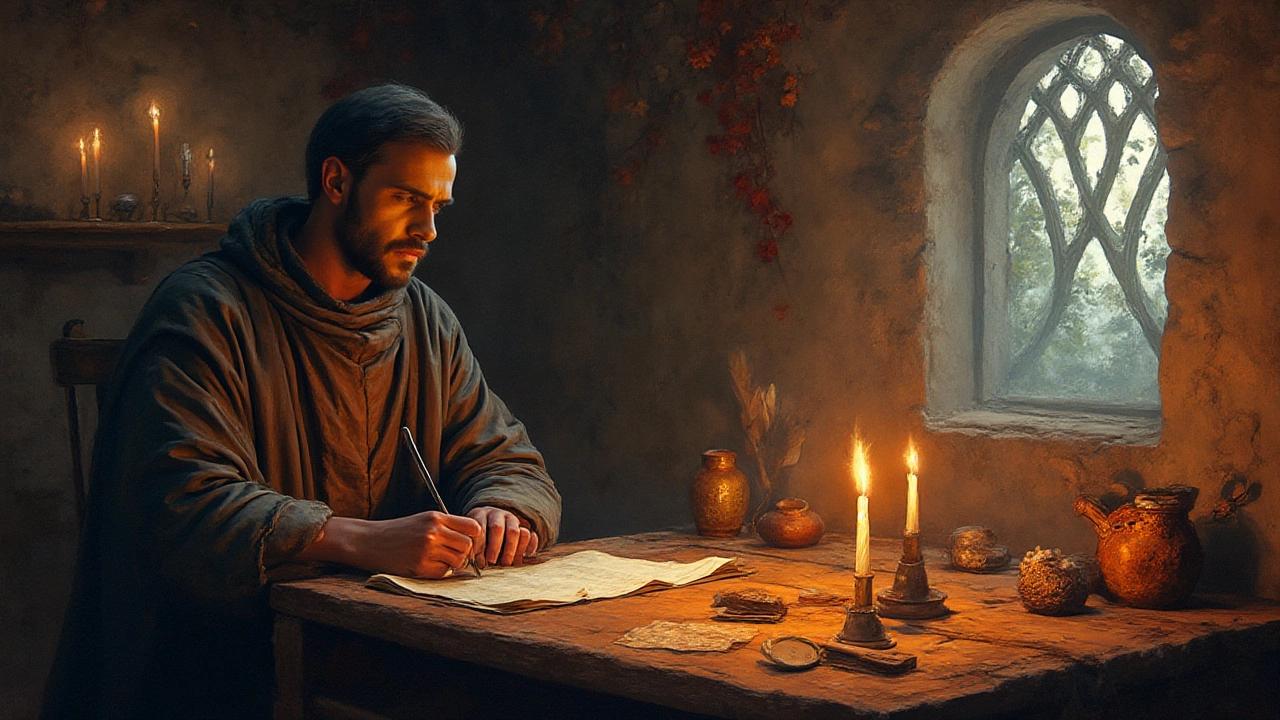Oldest Surviving Old English Poem: Cædmon's Hymn Uncovered

If you rummage through the dust and drama of English history, you’ll find no shortage of surprises. Forget royalty, forget epic wars—the real thrill comes from a handful of almost mystical lines written by a shepherd more than 1,300 years ago. Picture monks hunched over flickering candles, scribbling strange runes onto thick animal skins. Against all odds, one little poem, just nine lines, survives to tell the story of the birth of English literature. It’s called Cædmon's Hymn. And yes, it’s even older than Beowulf. Some folks get this wrong, but the record is clear: Cædmon’s Hymn is the oldest surviving poem in Old English, and its tale is as curious as the language itself.
The Tale Behind Cædmon's Hymn: How An Illiterate Shepherd Changed Literature
Let’s set the stage. England, around the late 600s AD. The language still looks and sounds barely recognizable to our modern ears—think "Hwæt! We Gardena in geardagum" rather than "Hey, what’s up?". In this rough and rural setting, in a monastery called Whitby Abbey (yes, the same Whitby that pops up in gothic tales), a laborer worked the stables and maybe hummed a tune now and then. He was Cædmon—maybe a nobody. Or maybe someone who just never had the chance to speak out. Until, according to Bede’s Ecclesiastical History (written in Latin, by the way), an otherworldly dream set him on a different path.
Here’s the good bit: Cædmon, feeling awkward at a feast when it came to the singing, slipped away to the cows. That night, he dreamt someone demanded he sing about creation. He protested—he didn’t think he could. The mysterious figure insisted. Out came the lines that would change the game for Old English poetry: "Nu sculon herigean heofonrices Weard..." He woke, hurried to the Abbess Hilda, and the rest is scribbled on surviving bits of parchment.
What makes this wild is how Cædmon was, by all accounts, illiterate. He never learned to read, never touched a pen, yet managed to compose in a form so well-crafted that scribes preserved it. His hymn—just nine lines—has been called the seed from which the orchard of English literature grew. Pretty wild, considering the average lifespan and literacy rates of the time. The feat stands out all the more when you realize precious few other Old English works survived the centuries, thanks to Viking raids, fires, and simple decay.
The language itself in Cædmon’s Hymn is something alien and beautiful. Old English isn't just a dialect—it’s another world altogether, with a grammar that would baffle English majors and a rhythm that shouts “listen!” even today. The opening phrase is sometimes translated: “Now we must praise the Protector of the heavenly kingdom, the power of the Creator, and His counsel, the works of the Father of glory...” Not your average campfire song.
Cædmon’s Hymn spread fast—by medieval standards—copied into over twenty surviving manuscripts, some in the original Northumbrian dialect and others tweaked for southern readers. What keeps people hooked is the odd blend of simplicity and holy awe. There’s no grand battle or list of feasts—just a straightforward praise of God as Creator, using imagery from a world of farmland and kinship. And unlike Beowulf or the Exeter Book riddles, its authorship never slipped away into obscurity. We know the poet’s name, and we know the spark that lit the fire.

How Old English Poetry Stayed Alive: Survival, Scribes, and Samplers
Here’s a weird thing: Old English poetry wasn’t meant to be read in an armchair. It survived because of memory, performance, oral tradition. Cædmon’s Hymn kicks off a tradition where poems are passed on in feasting halls, in crowded monasteries, wherever people gathered to escape dark winters and gloomy weather. It’s the ultimate game of whispers, but in rhyme and rhythm. And that’s the secret sauce—you didn’t need a book. All you needed was a good ear and a willing audience.
What’s mind-blowing is how the actual words made it through time. Paper as we know it? Didn’t exist. Scribes used vellum: animal skin, time-consuming to make and precious as gold. These manuscripts had enemies everywhere—damp, fire, bugs, clumsy monks. When Vikings showed up, they weren’t looking for poems—they wanted treasure, and parchment didn’t count. Many poems vanished. But Cædmon’s Hymn was lucky. It survived, not in just one place, but copied out over and over in different versions, tucked into historical chronicles and margins by scribes who probably didn’t even agree on the spelling.
If you’re a visual learner, check this out:
| Old English Text | Modern English Translation |
|---|---|
| Nu sculon herigean heofonrices Weard | Now we must praise the Guardian of heaven’s kingdom |
| meotodes meahte and his modgeþanc | The Creator’s might and His mind’s purpose |
| weorc Wuldor-Fæder, swa he wundra gehwæs | The work of the Glorious Father, as He of every wonder |
Old English poetry was built for the ear just as much as the eye. Rhyme didn’t matter, but alliteration and beat ruled the day. You hear it even in translation—the lines thump with a kind of steady rhythm, echoing out across centuries. Picture a group gathered by firelight, listening intently, the musicality of the words keeping at bay the darkness just outside.
People sometimes think ancient poetry is stuffy or dry. Cædmon’s Hymn proves the opposite. This poem is quick, to the point, easy to remember—and that’s probably why it outlasted more complicated stuff. No dragons, no tragic heroes, just a burst of awe in nine tight lines.
Manuscript survival is quirky. Some don’t even mention the poem; others squeeze it in as a margin note. There are differences between them, because medieval copying went by ear or memory as much as eye. So, the Hymn as we know it actually exists in several versions. Which is authentic? Truth is, no one knows for sure. But the essence—muscular praise and rural imagery—remains the same.
Beowulf hogs the spotlight when folks talk Old English, but move closer and you’ll see Cædmon’s Hymn lurking in the shadows, fueling everything that came after. Historians even argue that without this humble hymn, the whole trajectory of English poetry could’ve been different. It’s kind of like discovering that rock music started from a campfire ballad—unexpected, but suddenly it all makes sense.
Now, for some fun facts you can drop at your next trivia night:
- The original poem is likely from sometime around 658–680 AD, predating even Beowulf by nearly 150 years.
- The Hymn is the oldest extant (still existing) poem with an identified author in any West Germanic language—not just in Old English.
- Bede included the hymn in his famous history, but he actually translated it into Latin before scribes later re-translated it into Old English verse for manuscript copying.
- There’s evidence Cædmon’s Hymn fueled a burst of Anglo-Saxon religious poetry—think the start of the whole Christian poetic tradition in England.
- More than 20 manuscript copies survive, but no two are exactly alike.

Learning From the Past: What Cædmon's Hymn Teaches Us About Language And Creativity
Why does Cædmon’s Hymn matter to us modern folks, who don’t even talk the same way anymore? Simple. It’s a living reminder of what language can do—and how creativity cuts through time. Here we have a poem literally born in a dream, passing through the centuries on battered scraps of skin, outlasting battles, invaders, and even whole dialects. There’s something electric about knowing the oldest surviving Old English poem came from a man outside the elite. He never learned to write…but his words have more staying power than warlords or kings.
So what can you take from this? Even if you feel you aren’t “qualified,” your own ideas can change the game. Poetry, after all, started not in some university seminar but around firesides and farmyards, shared by ordinary people. If you feel stuck about writing—or anything creative—it helps to look at Cædmon. The prompt was simple: sing about something bigger than you. Maybe that’s what good art always does.
Another twist: Old English poetry like Cædmon’s Hymn reminds us that culture is patchwork, not straight lines. There’s no “pure” tradition here—Latin, Old English, Norse, even Celtic influences swirl together in every line and legend. Translators have been twisting Cædmon’s words into modern English since the 1700s. If you fancy a challenge, you can even study it yourself. There are university courses and online readings dedicated to Old English—sort of like learning to decipher a code left behind for anyone curious enough to crack it.
If you’re itching to get your hands dirty, the manuscript copies aren’t all locked away in dusty libraries. Digital facsimiles from places like the British Library let you zoom in and see the actual letters penned ages ago, complete with smudges and last-minute corrections. There’s a unique thrill to seeing the real ink of a world long gone, but still speaking to you now.
Curious about pronunciation? There are recordings (some on YouTube, some on museum sites) where you can hear the Hymn chanted in reconstructed Old English. The sound is raw, full of rolling “r”s and sharp edges. It’s nothing like Shakespeare—and miles away from what we might read today. Yet it still delivers a kind of punch, proof that strong words outlast style.
Maybe that’s the real heart of it: the oldest surviving Old English poem isn’t just a curiosity or a historical artifact. It’s proof that even from the margins—from a cow-herder’s dream—something timeless can be born. If you write, sing, or just daydream, it’s a green light. Someone before you did too, in a world where parchment was precious and a good story was even more so.
Next time you hear about "ancient literature," remember the guy who sang to cows and accidentally became a legend. Cædmon’s Hymn still echoes, rattling the walls of English verse—and showing that sometimes, all you need is a spark and the guts to try.